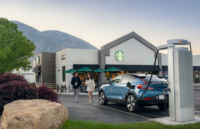Traditional OEMs face a challenge in the coming years as new competitors and fresh approaches to personal transportation appear. Daimler and Volvo are two of the old-guard leaders preparing for the new battle. According to recent interviews, full assaults on the IT (information technology) and safety fronts are just two of the highlighted strategies being deployed.
Influencing the Daimler business model
“I often get asked what I fear in my position leading the IT department and I always answer that it’s not the companies I know about, it’s the ones I don’t know about.” These words from the Chief Digital Officer from, as she put it, “the most successful premium car manufacturer in the world,” are a perfect example of how fast the automotive world has moved in a very short space of time.
The “she” in question is Sabine Scheunert and the company is Daimler. Gone are the days when its Mercedes-Benz luxury brand would count Audi and BMW as the biggest—and sometimes only—competition. Gone are the days too, in some cases, that people will choose to buy a vehicle, let alone one from the three German marques. And Scheunert knows it. “They have the pace, emotions, and passion to shape something new, and we might not have them on our radar,” she said, referring back to the startups, innovators, and mobility service providers who are lurking in the bushes, ready to pounce on Daimler customers.
“We have a responsibility as individuals and corporations, and it is us who will change the world into one that we want to be living in,” she said. “So we are asking the questions going beyond the CASE topics of autonomous and electric vehicles. We are asking ourselves important questions and see five trends where we defined our basic shared beliefs in how we think things will change and influence our business model.”
What Scheunert is talking about is Daimler’s so-called “5C-strategy” for the future, where it aims to “achieve profitable growth, increase the value of the company, and shape the future of mobility. The five Cs are: core business, culture, company, case studies, and—most importantly—customers.
“We’re dealing with more and more empowered consumers,” she said. “Look at smartphones where people are sharing and connecting so much. They have much higher expectations today because they simply know more. Consumers want a product that fits their lifestyle and their values, and while our challengers might have been Audi and BMW before, there are now more companies that we wouldn’t have considered challengers a few years ago, such as Uber, Apple, and even Tesla.”
Arguably a bigger issue than unknown competitors facing vehicle manufacturers is that of data—the sheer volume of it in vehicles and what to do with it.
“Big data has big meaning and we know the truth lays in data, but we need to really care about it and be responsible with it,” said Scheunert. “Having seen the stories coming out about data breaches, we need to ensure that whoever is handling all the petabytes of data we have is someone or a company who truly understands there is a responsibility to care.”
As a corporation, Scheunert emphasized the need for rebuilding trust within the digital economy: “When it comes to data and personal use of data, I think we are getting more sensitive about how important it is, and yet it was a crucial point for us when defining what it means to Daimler.”
Knowledge is power
Daimler is keen to move at the pace of some of the new kids on the block but is realistic that—as a legacy manufacturer—it’s sometimes easier said than done.
“As a car manufacturer, having systems that are often more than 30 years old that might not be in the cloud or have any sort of AI is important,” said Scheunert. “They drive our current business model. But as IT directors, we have the responsibilities to transfer these architectural systems into the new technological world with one clear aim: to be the digital champion in that industry, knowing that we have a legacy IT architecture that is probably not state-of-the-art.”
The age of the system, however, isn’t always a major issue for Scheunert because experience and years of data and information count for a lot.
“We have more information than you can imagine relating to what people do when it comes to mobility,” she said. “And it is here the question that the big game is around that knowledge and intelligence of that information.”
Scheunert dismissed the current cloud-based options, saying there was “little on offer in the market” and teased something from Daimler’s Stuttgart HQ.
“The major players are occupying the world; in most corporations, employees are sitting with their applications on those clouds,” she said. “Everyone bases their entire business process on cloud-based systems. We’re about to invent something that is going to radically change that—an offer that will drive mobility in a way that gives companies another option when choosing a cloud.
“IT plays a crucial role in the company and we are really transforming into a tech company. But for many years we have to exploit the current business model. We need to get the lemon and squeeze all of the juice out of it and then gain the necessary funding to invent what will be the next area to explore.”
Efficiency—when it comes to data—is another key area for Scheunert and her team.
“We are investing millions in exploring what we have as well as new approaches such as machine learning. Our strategy is clear; there are core topics on one side, and CASE (connected, autonomous, shared mobility, and electric] topics on the other.”
As the aforementioned “most successful premium car manufacturer in the world,” it’s imperative that Daimler keeps on top of both streams while looking over its shoulder for potential hazards in its way.
Volvo tackles causes of accidents with technology
Volvo made plenty of headlines in March—and not necessarily just for its cars. At the beginning of the month the Swedish OEM announced that it would be imposing a 180-km/h (112-mph) limit on all of its cars from 2020 to highlight the dangers of speeding. The move was made as a complement to its Vision 2020 initiative, which aims for no one to be killed or seriously injured in a new Volvo by 2020.
Later in the month, there was more focus on driver behavior and control when Volvo unveiled the Care Key—a component that appears no different from a standard Volvo key, but that allows drivers to set limitations on the car’s top speed. The idea is that they can maintain a level of control over how their car is being used before lending it to other family members or to younger and/or inexperienced drivers such as teenagers who have only just received their driver’s license.
Volvo is keen to start conversations about whether carmakers have the right, or maybe even the obligation, to install technology in cars that changes their owners’ behavior, said the company’s President and Chief Executive Officer, Håkan Samuelsson. In the face of increased levels of connectivity and autonomy in the vehicle, the speed limit and the Care Key are both part of this initiative and illustrate how carmakers can take active responsibility for striving to achieve zero traffic fatalities by supporting better driver behavior.
“We believe that a carmaker has a responsibility to help improve traffic safety,” said Samuelsson. “Our recently announced speed limit fits that thinking, and the Care Key is another example. Many want to be able to share their car with friends and family, but are unsure about how to make sure they are safe on the road. The Care Key provides one good solution and extra peace of mind.”
With Volvo’s strong pedigree in safety initiatives and innovation, protecting the occupants is clearly the main priority with these features, but the company has also indicated there is a potential financial benefit with decreased insurance costs. As such, the Swedish manufacturer has engaged with insurance companies in several markets regarding special, favorable insurance to the Volvo community using these safety features.
Extreme safety measures
Alongside the Care Key, Volvo has also addressed the issue of intoxication and distraction behind the wheel as it says they are the two other main areas of safety concerns alongside speeding. Volvo cited U.S. NHTSA (National Highway Traffic Safety Administration) stats that show almost 30% of the traffic fatalities in 2017 involved drivers who were intoxicated.
Volvo’s attempt to combat the problem is through the use of camera technology—specifically installing cameras and sensors inside the vehicle to monitor the driver, taking control from them if necessary. Should the driver be identified as intoxicated or distracted, and not responding to warning signs or alarms, the forms of intervention would range from limiting the car’s speed to calling Volvo On Call for assistance to slowing the car down to a stop and parking it.
The cameras are set to be introduced early in the next decade and debut on all Volvos built on the next generation of Volvo’s scalable SPA2 vehicle platform.
“When it comes to safety, our aim is to avoid accidents altogether rather than limit the impact when an accident is imminent and unavoidable,” said Henrik Green, Senior Vice President, Research and Development at Volvo Cars. “In this case, cameras will monitor for behavior that may lead to serious injury or death.”
Volvo gave examples of such behavior as a complete lack of steering input for extended periods of time, drivers who are detected to have their eyes closed or off the road for extended periods of time, and extreme weaving across lanes or excessively slow reaction times.
“There are many accidents that occur as a result of intoxicated drivers,” said Trent Victor, professor of driver behavior at Volvo Cars. “Some people still believe that they can drive after having had a drink, and that this will not affect their capabilities. We want to ensure that people are not put in danger as a result of intoxication.”
Details on the exact amount of cameras and their positioning in the interior of the new Volvos will follow at a later stage.










